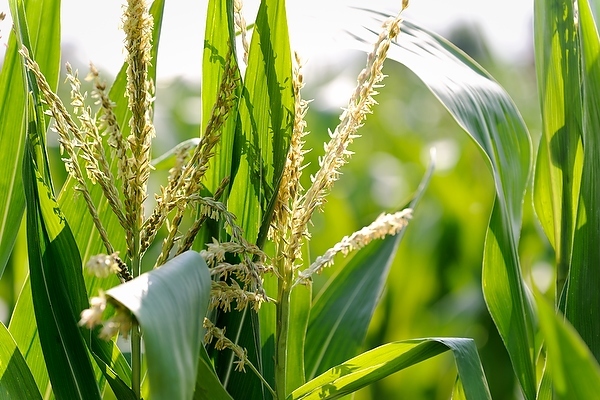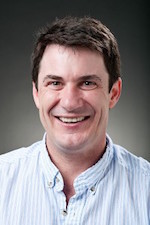UW botanist harnesses the grid to illuminate crop growth

Corn tassels and leaves are backlit by the sun at UW–Madison’s West Madison Agricultural Research Station. Botany Professor Edgar Spalding is using new technology to better quantify the complex process of corn growth.
When Edgar Spalding crunches data on Wisconsin corn, the numbers boggle the mind. Four million acres are planted annually, with 30,000 seeds planted per acre, producing about 120 billion seedlings sprouting skyward each May.
“I don’t even know how to think about that number,” says Spalding, a professor of botany at the University of Wisconsin–Madison. “How many stars are there in the Milky Way? One hundred billion? So we have a galaxy’s worth of corn seedlings cranking up in the soil every spring, just in Wisconsin alone.”
With help from the Center for High Throughput Computing (CHTC), Spalding is applying this astronomical sense of scale to our understanding of corn. Spalding uses the HTC capabilities pioneered by Miron Livny, Morgridge Institute for Research chief technology officer, to quantify the incredibly complex process of corn growth from seed to vigorous seedling — not just one at a time, but over thousands of samples.

Edgar Spalding
With the power and automation provided by the software tools and computing resources of the CHTC, Spalding is addressing a major gap in what we know about crop development. Corn is one of the most-studied plants in the world, Spalding says. We have fully sequenced its genome and have detailed information of thousands of different genetic varieties.
What’s missing is a robust understanding of corn phenotypes — the plant’s expression of its genetic recipe, such as its growth rate, weather resistance, ear size or kernel density. Most of that work today is still done by hand or by observation: for instance, counting the number of seedlings per row, the number of days to flowering, or the number of kernels per ear.
Spalding wants to bring the same level of sophistication to measuring phenotype expression that we bring to genomic information. The results will be a better connection between the genotype and the phenotype, and the ability to predict how different crop breeds will perform.
“That’s what everyone wants to do, to get more predictive about this business,” says Spalding. “Our chances of getting predictive are improved when we make a lot of measurements and get big data sets from which to predict.”
HTC enables Spalding and his collaborators to remove the subjectivity, increase the precision, and ramp up the volume on phenotyping enough to one day add value to optimizing field crops, he says.
Spalding’s Birge Hall lab is pretty far removed from conventional dirt-under-the-nails botany. In one room, a row of stationary cameras bathed in red light train in on petri dishes that contain seedlings growing in a gel. These cameras take pictures every two minutes, producing rich time-lapse composites of the plant’s growth. A second room follows the same process, but with a robotic arm that moves a single camera across a gantry of more than 30 petri dishes.
Every night, these imaging data are shipped en masse to the CHTC for analysis. The data that come back measure the phenotype performances across thousands of specific genetic variations in the plants, something that would be impossible without the computing power the CHTC harnesses from computers across the campus and the nation. The project uses tens of thousands of computer CPU hours weekly during peak times.
And just recently, Spalding has been making the leap from lab to field. Teaming with UW–Madison agronomists Shawn Kaeppler and Natalia de Leon at the West Madison Agricultural Research Station, Spalding is using stationary cameras along rows of corn, teamed with GPS-directed drones that can capture growth across entire crop rows.
These types of measurements will be a game changer for Spalding’s work. “If we’re successful moving to the field, that will have dramatic growth potential for image-based phenotyping,” he says. “Now we’re talking acres, not petri plates.”
Some early applications already look promising. One might be a better way to measure hybrid vigor. While crossing two genetic strains of corn almost always produces better-performing offspring, the process is not well understood. Spalding has developed a time-lapse imaging approach that can show hybrid performance in the first 24 hours of growth, offering a faster, cheaper and more accurate way to identify the best hybrids.
“If we’re successful moving to the field, that will have dramatic growth potential for image-based phenotyping. Now we’re talking acres, not petri plates.”
Edgar Spalding
“You could take this computer vision approach, screen thousands of potentials, look for the winners and pull out the dogs before they take up field space,” he says. “That’s all done now through expensive field trials.”
A second application with proven success is in measuring the ear traits of corn. Since each corn plant only produces two ears, getting ears of good size with high kernel density is important. This work is literally done by hand, counting individual rows of kernels.
Spalding’s team has developed an imaging pipeline that first uses flatbed document scanners to take a complete scan of each ear. The scan then goes through an image processing algorithm that records all features important to the ear. This workflow is then married with the HTC hardware at Morgridge, making it possible to analyze thousands of ears of corn in short time and match genetics with the best traits.
Recognizing the clear commercial potential of Spalding’s work, the Wisconsin Alumni Research Foundation (WARF) is seeking patents on some of Spalding’s computer vision algorithms. Spalding himself is investigating a spinoff company in partnership with the UW–Madison’s Discovery to Product, or D2P, initiative.
“This is a new science and it’s replacing a lot of tedious manual science,” Spalding says. “Hopefully people will start to measure phenotypes this way rather than pulling out the ruler and hiring undergraduates to count how many plants come up.”
This project has been supported since 2006 by the National Science Foundation’s Plant Genome Research Program.
A brief time-lapse clip of the field work, complete with a storm blowing through, is available for viewing, as well as a clip showing parent seeds on left and right, compared to the hybrids in center.




